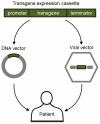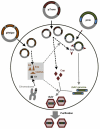State-of-the-art human gene therapy: part I. Gene delivery technologies
- PMID: 25091489
- PMCID: PMC4440413
State-of-the-art human gene therapy: part I. Gene delivery technologies
Abstract
Safe and effective gene delivery is a prerequisite for successful gene therapy. In the early age of human gene therapy, setbacks due to problematic gene delivery vehicles plagued the exciting therapeutic outcome. However, gene delivery technologies rapidly evolved ever since. With the advancement of gene delivery techniques, gene therapy clinical trials surged during the past decade. As the first gene therapy product (Glybera) has obtained regulatory approval and reached clinic, human gene therapy finally realized the promise that genes can be medicines. The diverse gene delivery techniques available today have laid the foundation for gene therapy applications in treating a wide range of human diseases. Some of the most urgent unmet medical needs, such as cancer and pandemic infectious diseases, have been tackled by gene therapy strategies with promising results. Furthermore, combining gene transfer with other breakthroughs in biomedical research and novel biotechnologies opened new avenues for gene therapy. Such innovative therapeutic strategies are unthinkable until now, and are expected to be revolutionary. In part I of this review, we introduced recent development of non-viral and viral gene delivery technology platforms. As cell-based gene therapy blossomed, we also summarized the diverse types of cells and vectors employed in ex vivo gene transfer. Finally, challenges in current gene delivery technologies for human use were discussed.
Figures




Similar articles
-
The future of human gene therapy.Mol Aspects Med. 2001 Jun;22(3):113-42. doi: 10.1016/s0098-2997(01)00004-8. Mol Aspects Med. 2001. PMID: 11470139 Review.
-
Viral vectors for gene transfer: a review of their use in the treatment of human diseases.Drugs. 2000 Aug;60(2):249-71. doi: 10.2165/00003495-200060020-00002. Drugs. 2000. PMID: 10983732 Review.
-
Progresses towards safe and efficient gene therapy vectors.Oncotarget. 2015 Oct 13;6(31):30675-703. doi: 10.18632/oncotarget.5169. Oncotarget. 2015. PMID: 26362400 Free PMC article. Review.
-
Engineered Non-Viral Gene Vectors for Combination Cancer Therapy: A Review.J Biomed Nanotechnol. 2017 Dec 1;13(12):1565-1580. doi: 10.1166/jbn.2017.2489. J Biomed Nanotechnol. 2017. PMID: 29490748 Review.
-
Adenoviral vectors for cardiovascular gene therapy applications: a clinical and industry perspective.J Mol Med (Berl). 2022 Jun;100(6):875-901. doi: 10.1007/s00109-022-02208-0. Epub 2022 May 24. J Mol Med (Berl). 2022. PMID: 35606652 Free PMC article. Review.
Cited by
-
Evaluation of a rapid multi-attribute combinatorial high-throughput UV-Vis/DLS/SLS analytical platform for rAAV quantification and characterization.Mol Ther Methods Clin Dev. 2024 Jul 15;32(3):101298. doi: 10.1016/j.omtm.2024.101298. eCollection 2024 Sep 12. Mol Ther Methods Clin Dev. 2024. PMID: 39170800 Free PMC article.
-
Magnet-Bead Based MicroRNA Delivery System to Modify CD133+ Stem Cells.Stem Cells Int. 2016;2016:7152761. doi: 10.1155/2016/7152761. Epub 2016 Oct 4. Stem Cells Int. 2016. PMID: 27795713 Free PMC article.
-
Gene therapy in neuromuscular disorders.Arq Neuropsiquiatr. 2022 May;80(5 Suppl 1):249-256. doi: 10.1590/0004-282X-ANP-2022-S135. Arq Neuropsiquiatr. 2022. PMID: 35976325 Free PMC article. Review.
-
Lysosomal storage diseases: current therapies and future alternatives.J Mol Med (Berl). 2020 Jul;98(7):931-946. doi: 10.1007/s00109-020-01935-6. Epub 2020 Jun 11. J Mol Med (Berl). 2020. PMID: 32529345 Review.
-
Gene therapy approaches for the treatment of retinal disorders.Discov Med. 2016 Oct;22(121):221-229. Discov Med. 2016. PMID: 27875674 Free PMC article. Review.
References
-
- Aiuti A, Cattaneo F, Galimberti S, Benninghoff U, Cassani B, Callegaro L, Scaramuzza S, Andolfi G, Mirolo M, Brigida I, Tabucchi A, Carlucci F, Eibl M, Aker M, Slavin S, Al-Mousa H, Al Ghonaium A, Ferster A, Duppenthaler A, Notarangelo L, et al. Gene therapy for immunodeficiency due to adenosine deaminase deficiency. N Engl J Med. 2009;360(5):447–458. - PubMed
-
- Argyros O, Wong SP, Harbottle RP. Non-viral episomal modification of cells using S/MAR elements. Expert Opin Biol Ther. 2011;11(9):1177–1191. - PubMed
Publication types
MeSH terms
Grants and funding
LinkOut - more resources
Full Text Sources
Other Literature Sources
Medical
Research Materials
Miscellaneous

